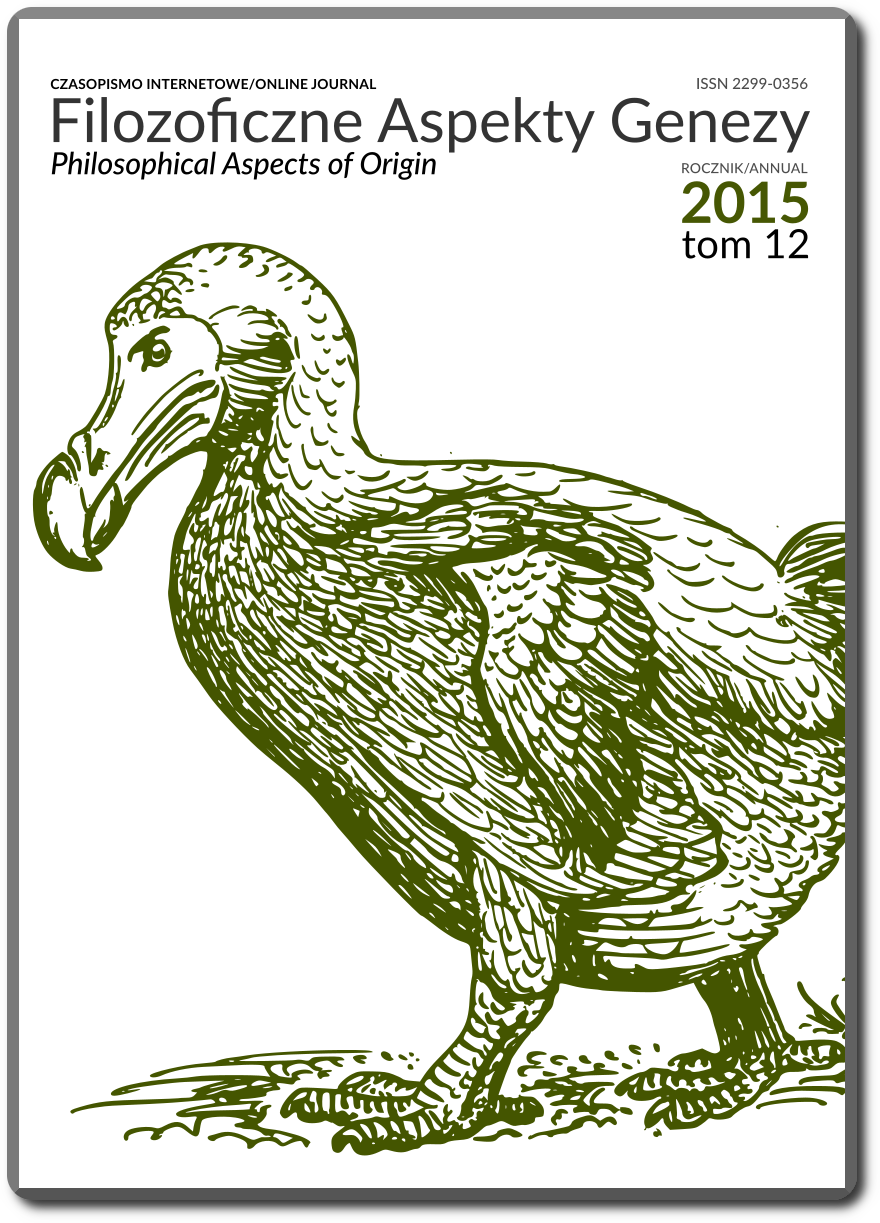Mark Harris as a Naturalistic Theist: The Perspective of the Model of Levels of Analysis
Opublikowane 24.05.2021
Słowa kluczowe
- theism,
- naturalism,
- naturalistic theism,
- science and religion,
- Mark Harris
- biblical studies ...More

Utwór dostępny jest na licencji Creative Commons Uznanie autorstwa 4.0 Międzynarodowe.
Jak cytować
Abstrakt
Presently, naturalistic theism is the dominant position in the debate on the relation between science and religion, defending a thesis that the conflict between science and religion is only an apparent one. Also, this version of theism accepts the naturalist assumptions behind contemporary science and attempts to reformulate the beliefs held within the traditional Christian theism in order to present the religious view of reality as not conflicting with the scientific picture of the world. Certain assumptions behind Mark Harris’s views on the relations between science and religion can be described as consistent with naturalistic theism. The model of levels of analysis helps to analyze the most important themes found within naturalistic theism and show how these are described in the works of Harris. The model facilitates the identification of the relations between particular kinds of assumptions behind the position taken from the point of view of naturalistic theism in the debate on the relation between science and religion. The list of most frequently recurring assumptions — that are also important in Harris’s writings — include: the general division of epistemic competence, which assumes theology (religion) to be competent in dealing with the metaphysical issues (Levels 1 and 2) and science to be the only one competent to deliver the empirical statements describing processes and entities found within the empirical sphere (Levels 4 and 5); the acceptance of the naturalistic assumptions behind contemporary science (Level 2) and skepticism toward the religious notions found in the traditional Christian theism describing supernatural interventions and toward the dualist interpretation of human soul (Level 3). This leads to the acceptance of purely scientific, naturalistic, explanations of the events found within the empirical sphere and to skepticism toward the literal meaning of descriptions of empirical events (Level 5) that are not consistent with the anti-interventionist assumptions behind science. Harris’s acceptance of naturalistic theism in terms of the relation between science and religion and his use of the techniques found in the modern biblical scholarship have led him to the ideas of plurality of meanings and the lack of one definite truth with respect to the specific issues he deals with. From the point of view of MLA it is the rejection of super-naturalistic assumptions of the traditional Christian theism and the acceptance of the naturalistic assumptions of science that seems to be the cause of lack of definite truth in his theological explanations.
Downloads
Bibliografia
- Harris Mark, The Nature of Creation: Examining the Bible and Science, Acumen, Durham 2013.
- Van Der MEER Jitse, “Review (Mark Harris, The Nature of Creation: Examining the Bible and Science, Acumen, Durham 2013)”, ESSSAT News & Reviews 2015, vol. 25, no. 4, pp. 24-27.
- Bylica Piotr, “Główne założenia i problemy teizmu naturalistycznego w sprawie relacji sfery nadprzyrodzonej i świata przyrodniczego”, in: Wiesław Dyk (ed.), Sozologia systemowa: Biosfera. Człowiek i jego środowisko w aspekcie przyrodniczym, filozoficznym i teologicznym, vol. IV, Wydawnictwo Naukowe Uniwersytetu Szczecińskiego, Szczecin 2014, pp. 55-95.
- http://www.blogs.hss.ed.ac.uk/science-and-religion/page/2/ (30.06.2014).
- Bylica Piotr, “Levels of Analysis in Philosophy, Religion and Science”, Zygon 2015, vol. 50, no. 2, pp. 304-328.
- Bylica Piotr, “Zarys modelu poziomów analizy w badaniach relacji nauki i religii”, Filozoficzne Aspekty Genezy 2012, vol. 9, pp. 221-253.
- Barbour Ian G., Myths, Models and Paradigms: A Comparative Study in Science and Religion, Harper & Row Publishers New York — Evanston — San Francisco — London 1974.
- Murphy Nancey C., “Theology and Science within a Lakatosian Program”, Zygon: Journal of Religion and Science 1999, vol. 34, no. 4, pp. 629-642.
- Jodkowski Kazimierz, Metodologiczne aspekty kontrowersji ewolucjonizm-kreacjonizm, Realizm. Racjonalność. Relatywizm, vol. 35, Wyd. UMCS, Lublin 1998.
- Jodkowski Kazimierz, “NOMA, cudy i filtr eksplanacyjny”, Roczniki Filozoficzne 2005, vol. 53, no. 2, pp. 83-103.
- Jodkowski Kazimierz, “Epistemiczne układy odniesienia i «warunek Jodkowskiego»”, in: Anna Latawiec and Grzegorz Bugajak (eds.), Filozoficzne i naukowo-przyrodnicze elementy obrazu świata. T. 7, Wydawnictwo Uniwersytetu Kardynała Stefana Wyszyńskiego, Warszawa 2005, pp. 108-123.
- Jodkowski Kazimierz, “Dlaczego kreacjonizm jest pseudonauką?”, in: Józef Zon (ed.), Pogranicza nauki. Protonauka — paranauka — pseudonauka, Wydawnictwo KUL, Lublin 2009, pp. 317-323.
- Peacocke Arthur R., Paths from Science toward God: The End of All Our Exploring, Oneworld, Oxford 2001.
- Heller Michał, “Chaos, Probability, and the Comprehensibility of the World”, in: Robert J. Russell, Nancey Murphy, and Arthur R. Peacocke (eds.), Chaos and Complexity, Scientific Perspectives on Divine Action, Vatican Observatory Publications and CTNS, Vatican — Berkeley 1995, pp. 107-121.
- Wszołek Stanisław, “W obronie argumentu God of the gaps”, Zagadnienia Filozoficzne w Nauce 1999, vol. XXIII, pp. 103-118.
- Ayala Francisco J., Am I a Monkey? Six Big Questions about Evolution, John Hopkins University Press, Baltimore 2010.
- Barbour Ian G., When Science Meets Religion, Harper, San Francisco 2000.
- Barbour Ian G., Issues in Science and Religion, Harper & Row, New York — Hagerstown — San Francisco — London 1971.
- Polkinghorne John C., One World: Interaction of Science and Theology, Templeton Foundation Press, Philadelphia and London 2007.
- Miller Kenneth R., Finding Darwin’s God: A Scientist’s Search for Common Ground Between God and Evolution, Cliff Street Books, New York 1999.
- Saunders Nicholas, Divine Action and Modern Science, Cambridge University Press, Cambridge 2002.
- Bonhoeffer Dietrich, Letters and Papers from Prison: The Enlarged Edition, SCM Press, London, Letter to Eberhard Bethge, 29 May 1944.
- Polkinghorne John C., Beyond Science: The Wider Human Context, Cambridge University Press, Cambridge 2002.
- Życiński Abp. Józef, Bóg i ewolucja. Podstawowe pytania ewolucjonizmu chrześcijańskiego, Prace Wydziału Filozoficznego, vol. 89, Wyd. TN KUL, Lublin 2002.
- Harris Mark, “Does Jesus Have a Soul?: The Apollinarian Controversy Revisited”, in: Michael Fuller (ed.), The Concept of the Soul: Scientific and Religious Perspectives, Cambridge Scholars Publishing, Newcastle upon Tyne 2014, pp. 75-81.
- Murphy Nancey, “Divine Action in the Natural Order: Buridan’s Ass and Schӧdinger’s Cat”, in: Robert J. Russell, Nancey Murphy, and Arthur R. Peacocke (eds.), Chaos and Complexity, Scientific Perspectives on Divine Action, Vatican Observatory Publications and CTNS, Vatican — Berkeley 1995, pp. 325-358.
- Russell Robert J., “Special Providence and Genetic Mutation: A New Defense of Theistic Evolution”, in: Robert J. Russell, William R. Stoeger, and Francisco Ayala (eds.), Molecular Biology, Scientific Perspectives on Divine Action, Vatican Observatory and CTNS, Rome — Berkeley 1998, pp. 191-223.
- Russell Robert J., “Divine Action and Quantum Mechanics: A Fresh Assessment”, in: Robert John RUSSELL, Philip Clayton, Kirk Wegter-McNelly, and John C. Polkinghorne (eds.), Quantum Mechanics, Scientific Perspectives on Divine Action, Vatican Observatory Publications, Center for Theology and the Natural Sciences Vatican City State — Berkeley 2001, pp. 293-328.
- Russell Robert John, Cosmology: From Alpha to Omega: The Creative Mutual Interaction of Theology and Science, Theology and the Sciences, Fortress Press, Minneapolis 2008.
- Tracy Thomas F., “Particular Providence and the God of the Gap”, in: Robert J. Russell, Nancey Murphy, and Arthur R. Peacocke (eds.), Chaos and Complexity, Scientific Perspectives on Divine Action, Vatican Observatory Publications and CTNS, Vatican — Berkeley 1995, pp. 289-324.
- Ellis George, “Ordinary and Extraordinary Divine Action: The Nexus of Interaction”, in: Robert J. Russell, Nancey Murphy, and Arthur R. Peacocke (eds.), Chaos and Complexity, Scientific Perspectives on Divine Action, Vatican Observatory Publications and CTNS, Vatican — Berkeley 1995, pp. 359-396.
- Peacocke Arthur R., “God’s Interaction with the World: The Implications of Deterministic «Chaos» and of Interconnected and Interdependent Complexity”, in: Robert J. Russell, Nancey Murphy, and Arthur R. Peacocke (eds.), Chaos and Complexity, Scientific Perspectives on Divine Action, Vatican Observatory Publications and CTNS, Vatican — Berkeley 1995, pp. 263-288.
- Polkinghorne John C., Science and Providence: God’s Interaction with the World, New Science Library, Shambala — Boston 1989.
- Polkinghorne John, “The Metaphysics of Divine Action”, in: Robert J. RUSSELL, Nancey MURPHY, and Arthur R. Peacocke (eds.), Chaos and Complexity, Scientific Perspectives on Divine Action, Vatican Observatory Publications and CTNS, Vatican — Berkeley 1995, pp. 147-156.
- Lewis Clive S., Miracles: A Preliminary Study, Collins, Glasgow 1977 (1st ed. 1947).
- Lewis Clive S., “Modern Theology and Biblical Criticism”, in: Clive S. LEWIS, The Seeing Eye: And Other Selected Essays from Christian Reflections, Ballantine Books, New York 1986, pp. 203-223.
- Lewis Clive S., “Miracles”, in: Clive S. LEWIS, The Grand Miracle: And Other Selected Essays on Theology and Ethics from God in the Dock, Ballantine Books, New York 1983.
- Plantinga Alvin, “Divine Action in the World (Synopsis)”, Ratio (New Series) 2006, vol. 19, pp. 495-504.
- Plantinga Alvin, “Two (or More) Kinds of Scripture Scholarship”, Modern Theology 1998, vol. 14, no. 2, pp. 243- 278.
- Plantinga Alvin, “What Is «Intervention»?”, Theology and Science 2008, vol. 6, no. 4, pp. 369-401.
- Harris Mark, “How Did Moses Part the Red Sea?: Science as Salvation in the Exodus Tradition”, in: Axel GRAUPNER and Michael WOLTER (eds.), Moses in Biblical and Extra-Biblical Traditions, de Gruyter, Berlin — New York 2007, pp. 5-31.
- Harris Mark, “Will Resurrection Be a Law of Nature?: Science as Divine Action at the End of the World”, in: Louise HICKMAN (ed.), Chance or Providence?: Religious Perspectives on Divine Action, Cambridge Scholars Publishing, Newcastle upon Tyne 2014, pp. 21-44.
- Johnstone William, “Review of Humphrey’s The Miracles of Exodus”, Journal of Semitic Studies 2005, no. 50, pp. 373-379.
- Harris Mark, “Science, Scripture, and the Hermeneutics of Ascension”, Theology and Science 2014, vol. 12, no. 3, pp. 201-215.
- Barbour Ian G. (ed.), Science and Religion: New Perspectives on the Dialogue, Harper & Row, New York — Evanston — London 1968.



